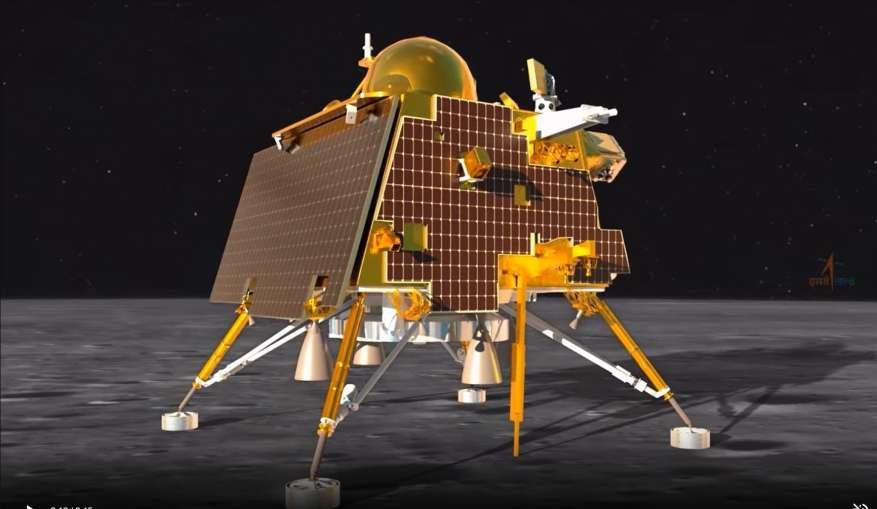The Chadrayaan-3 mission landed with success on the Moon’s south pole. Making India the fourth country to land on Earth’s natural satellite.
The soft landing happened today, at 18:03 IST. The other three countries that made the same feat are USA, Soviet Union and China.
Source: Space.com
Soon, a solar-powered rover named Pragyan (Sanskrit for “wisdom”) is expected to roll off Chandrayaan-3’s Vikram (“valor”) lander. The robotic duo will spend one lunar day (about 14 Earth days) exploring its new home, with the goal of collecting scientific data about the moon’s makeup before its batteries drain after sunset.

Chandrayaan-3 was India’s second try at landing near the moon’s south pole, a largely uncharted region of immense interest to scientists and exploration advocates alike. The south polar region is thought to harbor large amounts of water ice, which, if accessible, could be mined for rocket fuel and life support for future crewed missions. The country’s first attempt at a lunar touchdown, in September 2019, failed when the Chandrayaan-2 lander crashed into the moon due to a software glitch.
Close to four years and many design and software upgrades later, the homegrown Chandrayaan-3 spacecraft launched atop a LVM3 rocket on July 14 from a spaceport in Sriharikota, on India’s east coast. The spacecraft entered an elliptical orbit around the moon earlier this month, then performed multiple maneuvers to shift into a nearly circular path, which took it about 93 miles (150 kilometers) above the lunar surface.
Last Thursday (Aug. 17), the Vikram-Pragyan duo separated from the mission’s propulsion module, which will study Earth from its orbit around the moon. The lander and rover, which had entered an egg-shaped lunar orbit after separation, braked successfully on Friday (Aug. 18) and then again on Sunday (Aug. 20) to get closer to the moon’s surface.
While still in orbit around the moon on Monday (Aug. 21) and Tuesday (Aug. 22), the duo established contact with Chandrayaan-2’s orbiter, which has been circling the moon since 2019 and will serve as the critical communication link with Earth for the Chandrayaan-3 mission.
When the sun rose today on the targeted landing site, which was seen from Earth on one edge of the moon, mission control at ISRO’s headquarters in Bengaluru commanded the lander to begin its descent to the lunar surface, activating its fully automatic landing system.

Chandrayaan-3 landed close to the site where Luna-25 probe would be, which unfortunately wasn’t able to make a soft landing.
India’s success today can be attributed to “extensive changes” to its landing strategy after Chandrayaan-2’s 2019 crash, said Anil Bhardwaj, director of the Physical Research Laboratory (PRL) in India. Onboard algorithms that calculate spacecraft speed in real time during descent were reworked to allow for “more freedom to deviate” from protocol “but still do the landing,” he added.
Other changes that helped facilitate the mission’s success include a larger target landing zone, stronger legs for Vikram to withstand higher landing speeds and dynamic engines that adjusted the spacecraft’s velocity for a smoother touchdown.
Now that Vikram is settled on the moon, Pragyan is expected to roll onto the lunar surface and start analyzing lunar soil and rocks.
Modules of Chandrayaan-3

According to ISRO, Vikram’s scientific instruments are:
- Radio Anatomy of Moon Bound Hypersensitive Ionosphere and Atmosphere (RAMBHA): to measure ion and electron density and variation on surface.
- Chandra’s Surface Thermo physical Experiment (ChaSTE): measure surface’s thermal properties.
- Instrument for Lunar Seismic Activity (ILSA): measure seismic activity around the landing site, delineating the structure of crust and mantle.

The rover’s scientific instruments:
- Laser Induced Breakdown Spectroscope (LIBS): to make quantitative and qualitative analysis and infer rocks and soil composition.
- Alpha Particle X-ray Spectrometer (APXS): determine elementary composition of lunar soil and rocks.

The propulsion module has the Spectro-polarimetry of HAbitable Planet Earth (SHAPE), whose function is to help find habitable exoplanets or the ones that can contain life.



